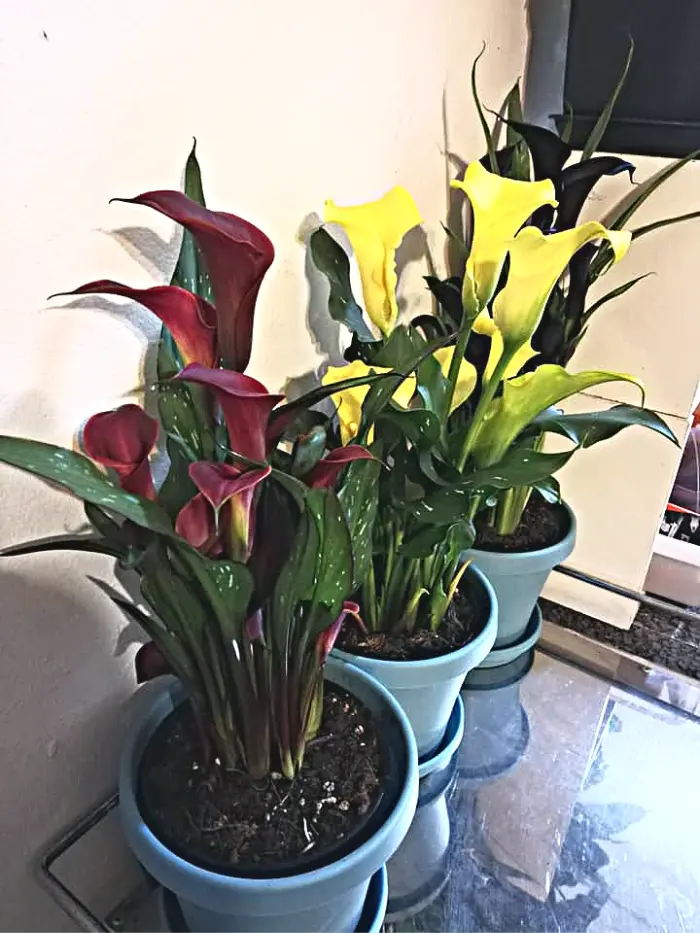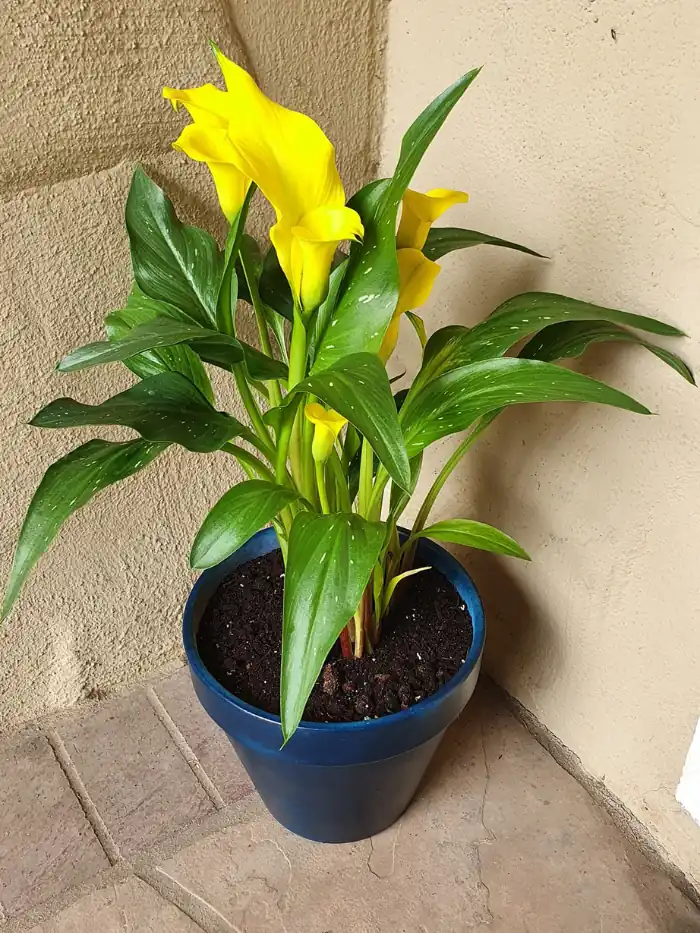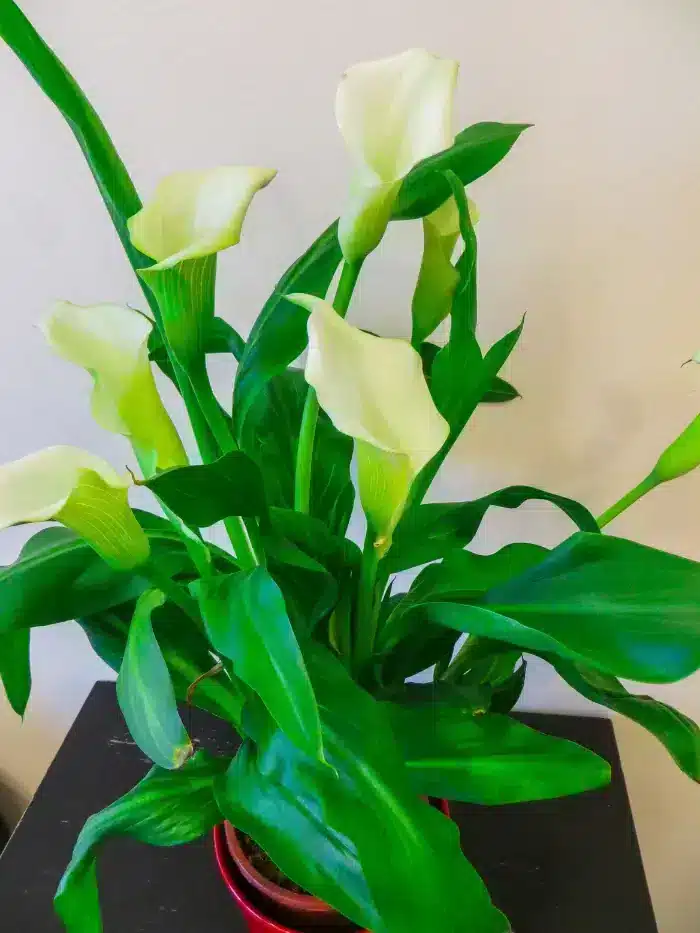Are Calla Lilies Annuals or Perennials? [EXPLAINED]
Calla lilies (Zantedeschia sp.) behave differently in various climatic zones, making most gardeners wonder whether they are annuals or perennials. They get damaged or die in some zones in winter; in others, they go dormant and bloom again in the active growing season.
So, are calla lilies annual or perennial plants?
Calla lilies are perennials and not annuals. However, they are susceptible to freezing temperatures below 25°F, which kills or damages their roots and bulbs. In warmer climates, outdoor calla lilies don’t die. Instead, they go dormant and come back in the spring.
Potted calla lilies can remain active all year round under optimal growth conditions, but I have seen many instances where they go dormant or appear to die down after flowering but come back soon after winter is over.

Annual vs Perennial Plants
| Perennial plants | Annual plants |
| Perennial plants live for more than two years and can grow and reproduce multiple times during their lifespan. Unlike annuals that complete their life cycle in a single growing season and die after producing seeds, perennials can survive winter and resume growth and reproduction the following year. | Annual plants complete their entire life cycle within a single growing season, from germination to flowering and seed production, and then die. They are generally known for their quick growth and prolific flowering, but do not survive the winter season in temperate regions. |
| Examples of perennial plants are calla lilies, daylilies, salvia, peonies, and coral bells. | Examples of perennial plants are marigolds, petunias, and zinnias. |
Calla lilies are tender, herbaceous perennials which can bloom again after frosts or cold winters, depending on how you treat them and where you place them.
Callas are native to South Africa and perform well in the USDA zones 8 to 11, where there are no freezing temperatures. They can stay outside year-round in these zones and bloom again in the following growing season.
However, those planted in USDA zones below 8 experience temperatures below 25°F in winter, damaging and killing the plants.
If you have potted calla lilies that bloom and appear to die over time, treat them to make them bloom again instead of disposing of them.
How to make calla lilies grow again in USDA Zones below 8
If you want your calla lilies to regrow again but live in the USDA hardiness zones below 8, do the following when a frost is approaching:
1. Overwinter the calla lilies
You can overwinter your calla lilies by digging up their rhizomes in the fall and storing them during winter.
Carefully dig out the calla lily rhizomes and keep them in a cool, dry place for about 1-2 weeks to let them dry.
Afterward, remove brown leaves and dip the rhizomes in sawdust, peat moss, or vermiculite. Store them in a cool, dry place with a temperature of 50°F- 60°F. Replant the bulbs in the spring after the frost is over.
2. Shelter potted calla lilies
Bring potted calla lilies inside, and place them in a sunny location. Let them go dormant by not watering them. After the frost, start watering to revive them.
How do calla lilies spread?

Calla lilies spread or propagate through seeds or bulb division.
Seed propagation
Callas propagation by seed can take up to six years before the plant flowers, yet it can be more successful than division. Since calla lilies are hermaphrodites, they can self-pollinate to produce seeds.
Sowing is best done in early winter or late spring in pots. Their soil should be well-draining and organic matter rich. When first planted, the seeds will need warm conditions for about three months to support root growth.
The following six weeks should be cold, followed by a warm period where the stems and leaves start to grow.
Propagation by division
Propagating calla lilies by dividing bulbs from mature plants is the easiest way to spread them. Divisions take a shorter time to bloom than those grown from seeds.
Mature calla lilies may decline and produce fewer flowers because of crowded rhizomes, making it necessary to divide and replant them to rejuvenate and promote healthy blooms.
Divide mature calla lilies every 3-4 years before they decline. Divide them in spring for planters in USDA zones 8-11 but fall for those in colder climates. To propagate them by division, wait until the calla lilies bloom and their leaves turn brown.
Here’s how to propagate calla lily by division.
- For grounded calla lilies, dig a small circle around the plant’s roots and use a shovel to remove the rootballs—Moisten potted calla soil to make removing the plant easier. Hold the plant upside down, so it falls on your hands. Avoid pulling the plant from the container, as this may damage it.
- Wash off the soil around the bulbs and place it in a cool, dry place.
- Wait for a few days before cutting the rhizomes.
- Divide the bulbs using a sharp knife, ensuring each section has roots for grounding. Sterilize the knife in rubbing alcohol often to avoid transferring infections from one cut root section to another.
- Fill your pot with well-draining, organic-rich potting soil. A suitable container should be broad and have drainage holes underneath to pass excess water in case of overwatering. Each cut bulb should have its pot. If replanting the cut rootballs on the ground, make 10cm deep holes at least six inches apart.
- To each potting container, add one bulb with roothairs. The pot should have a little soil to place the bulbs. Add more potting soil until the root ball is completely covered. Otherwise, add the cut rootballs to the holes you had made on the ground and cover them with soil.
- Water the newly planted callas lightly and place potted ones in full sun or partial shade.
Can calla lilies be potted?
You can plant calla lilies in pots and place them indoors or outdoors. You must provide the correct sunlight, growing media, and water to make the plant thrive.
Use well-draining, organic-rich potting soil. The planter should have enough drainage holes to pass excess water, as soggy socials can cause root rot and fungal infections.
Callas prefer full sun to thrive. Place the pot under full sun. South-facing windows are the best locations. Water the plant when the first half inch of soil is dry.
If you live in colder climates below zone 8, bring potted callas inside when the frost is approaching and place them in a sunny location.
How long do calla lilies last?
Calla lilies bloom in fall, spring, and summer, according to the North Carolina state extension, and the blooms last for about four to six weeks. When blooming, they display showy, spadix flowers that can be white, orange, pink, lavender, gold, red, or gold, depending on the variety. With arrow-shaped, green and white-spotted leave,s calla lilies are terrific plants to behold when blooming.
Calla lily plants last year-round under the right climatic conditions.
Conclusion
Calla lilies are tender perennials and not annuals or biennials. But, they get damaged or die when exposed to freezing temperatures below 25oF. In USDA zones 8-11, calla lilies can stay outdoors year-round without dying.
Overwinter their rhizomes or bring potted ones indoors when a frost is approaching. To spread calla lies, plant their seeds or rhizome cuttings. Repot a declining plant to rejuvenate it.



